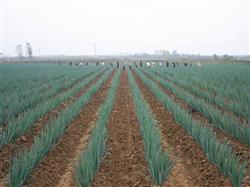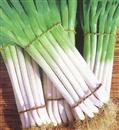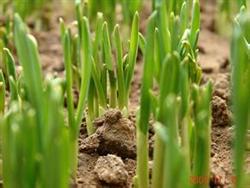Technical guidance on cultivation of Welsh Onion

First, raising seedlings: 1. Sowing time: according to the different requirements of the products, the seeds can be sown in four seasons. The best sowing time for high-yield Welsh onion is autumn sowing (the ten-day average temperature is 16.5 ℃-17 ℃, which is in the first ten days of October). The climatic conditions in the north and south of the country are different, and the sowing time is also different. the best time to determine the size of the seedlings before overwintering is easy to bolt in spring through vernalization, but it is too small to survive the winter safely. The standard of seedlings before winter is to grow to two leaves with one heart. Spring sowing comes before and after Ching Ming Festival. 2. Arrange the seedbed: the seedbed should choose the land which is flat, fertile, close to the water source and convenient for drainage. The nursery land should be shallow ploughed and fine raked before the whole bed, so that the upper and lower parts are loose and solid. 50 kg compound fertilizer per mu as base fertilizer, 2.5 kg Fulandan per mu and 0.5 kg carbendazim powder to kill underground pests and germs (very important). The border is 20-25 meters long, 1 meter wide, and the border ridge is 30 centimeters. After stepping on the border, it is flattened repeatedly with an iron rake, without bumps. 3. Sowing: take out the cover soil from the border before sowing, and then fill the border with enough water (the amount of irrigation must be large). After the water seeps, mix the seeds with sandy soil and sprinkle twice in the border (sprinkle evenly). Finally, cover the soil with a thickness of 1.5 cm-2 cm, cover the soil evenly, the amount of seed used in the seedling field is 1.3 kg, and you can transplant 5 mu of scallions, and the next morning after planting. Hold the border surface shallowly with an iron rake to prevent the soil from being uneven. Second, seedling management: 1, autumn sowing 7 days after emergence, spring sowing 8-12 days of emergence, cotyledons before the control of watering, so as to avoid hardening and silting seedlings, during the rain, the floor can be lightly scratched with iron rakes. When watering the first water, wait for the cotyledons to straighten. For weeding (herbicides cannot be used), the seedling grows to about 2 cm. When it is about straight, it is necessary to use medicine in time to prevent fungal diseases. Generally, it is sprayed every 5 days (mainly for the treatment of dead root rotten seedlings, virus and Botrytis cinerea). After the seedling grows to more than 5 cm, urea can be used to lift the seedling in time according to the soil fertility. 2. Before winter, we should mainly cultivate strong seedlings, its standard: the plant height is 8-10 cm, the true leaves reach two leaves in one heart, the leaves are green and robust, and the diameter of the base is not more than 0.3 cm. During this period, the humidity of the base area can be irrigated with 1-3 water, and before freezing, it is suitable to cover a layer of soil, miscellaneous fertilizer, plant ash or fine circle fertilizer, and its thickness is not exposed to the leaf sheath on the ground. 3. After sowing the Beginning of Spring seedlings in autumn, the roots, hearts and leaves of spring onion seedlings began to sprout, and the border surface was hugged to remove sundries to prevent pressing seedlings, so as to achieve moisturizing, warming and early growth. Watering green water in early March, but not easy to early, lest low temperature affect the early growth of onion seedlings, can be combined with watering 10 kg urea per mu to promote seedlings. From late March to early April, the height of the seedling was about 30 cm, and the interseedling was carried out for 1-2 times to keep the seedling spacing 3-5 cm. The height of seedlings is about 50 cm from late April to early May, which is the prosperous period of onion seedlings. In order to do a good job in fertilizer and water management, urea, diammonium and compound fertilizer can be applied by stages, at least twice, mostly three times, 10-15 kg each time, and combined with spraying compound micro-fertilizer for 2-3 times. Medicine should be used in time to prevent fungal diseases, and special attention should be paid to the control of onion maggots, onion thrips and leafminers. Stop watering 15 days before transplanting and squat seedlings to facilitate steady growth. 3. Transplanting and planting: 1. Select the land with high terrain, good drainage and fertile soil, which is best in the north-south direction. The base fertilizer can be 5000 kg per mu of farm fertilizer, 100kg phosphate fertilizer, 10kg urea, 15kg potash fertilizer, or 30kg diamine, or 50kg compound fertilizer, and then ploughing and drying the soil to eliminate the source of disease and weeds, improve fertility, and finally open ditches according to the ditch distance of 80cm, ditch depth and width of about 25cm. 2. It is suitable for early planting, generally from mid-June to early July, and should be watered once two days before seedling emergence. The roots should be deeply shaved, or lifted into handlebars, shaken off the soil, laid flat, and disabled seedlings and diseased seedlings should be eliminated. They are divided into three grades according to seedling size, height, height and thickness. In the case of seedling feet, third-grade seedlings are generally not used. It is necessary to keep the onion seedlings fresh when transplanting along with the grading and transplanting of onion seedlings. The suitable distance between transplanting plants is 3-4 cm. 3. Planting method: (1) dry planting method: after opening the ditch, the onion seedlings are arranged on one side of the ditch wall according to a certain plant distance, and the onion leaves are flat against the ditch wall, and then cultivate the soil with hoe. It is advisable to cultivate the soil deep without burying the heart leaves, and step on it after planting. Or plant it at a certain distance with a shovel, and then step on it. After planting, water should be watered again, and it is best not to stay in the water. (2) Water planting method: the selected seedlings are placed evenly on the back ridge, watered first in the ditch and infiltrated under water, and one person squats on the back of the ridge every 8-10 meters to cut. When cutting, the transplanting stick is made of peeled branches, with a "ⅴ" fork at the top, holding the seedling in the left hand and the transplanting stick in the right hand, using the fork to hold the whisker root of the onion seedlings, and take advantage of the soft soil at the bottom of the ditch to plant the onion seedlings directly. Different grades of seedlings should be planted in different plots or pieces, not juxtaposed in height and height, uneven in order to manage. Fourth, post-planting management: transplanting is in the hot season, high temperature and rain, generally do not water, rain and rain will lead to rotten roots and dead seedlings, we should pay attention to timely drainage. In case of high temperature and drought, it is necessary to water to cool down and promote growth. As the onion continues to grow, we should cultivate the soil in time, top fertilizer, the final ridge height of 70-80 cm, can not bury the heart leaves when cultivating the soil. Topdressing and soil cultivation are carried out at the same time, the first time should start from the Beginning of Autumn, 5000 kg of farm manure per mu, 10-15 kg of urea, and watering after application. The second topdressing the End of Heat was carried out, applying 15-20 kg urea per mu and 50 kg cake fertilizer. The third topdressing was in White Dew, when onion white entered the peak period of expansion, and fertilizer and water management was the key. 1000 kg of human feces and urine, 15 kg of urea, 50 kg of phosphate fertilizer and 5-10 kg of potash fertilizer could be applied along the ditch, and finally watered, and the fourth topdressing was carried out in the Autumn Equinox. 10-15 kg urea per mu, soil watering. White Dew should be sprayed with compound micro-fertilizer before and after, usually once every 5-7 days, 2-3 times in succession, the yield increase effect is obvious. Fifth, harvest and storage: before and after the Beginning of Winter, spring onions can be harvested and planed. After harvesting and planing, a bundle of 15kg is placed in a cool and ventilated place. 5. 6 bundles are kept in a cool and ventilated place, leaving a 50 cm passage between the rows. In case of high temperature, they should be unbundled and dried. They are afraid of heat in storage, not afraid of cold. Guard against Rain Water. 6, the main diseases and insect pests: 1, leaf miner: the main harm to the leaves, larvae sneak into the skin to eat mesophyll, leaving epidermis worms, due to the loss of green is white linear. 2. Onion thrips: it mainly harms the leaves, sucking the mesophyll to form white spots, and in severe cases, the whole leaves are grayish white due to chlorosis. 3. Onion maggots: mainly harm scallion white, stem disk and root in the ground, causing stem rot and leaf withering, causing lack of seedlings and broken gong. 4. Green onion purple spot: harmful to green leaves, the disease spot gradually expands to 3-5 cm from the small white spot, showing a fusiform or jujube core shape, the largest spot is 6-7 cm long, slightly sunken is dark purple, so it is called purple spot disease. 5. Green onion downy mildew: the diseased plant is twisted and dwarfed, with large yellow-white, oval disease spots like water impregnation, and the leaves droop and dry. 6. Green onion rust: commonly known as anthrax, it is a destructive disease in green onion producing areas. The disease spot occurs on the surface of tubular leaves and flower stems, initially round, oval or spindle-shaped, upright with the direction of leaf veins, dark yellow gradually turning into orange-brown, raised, scattered, spots of different sizes. The diseased plants wilted, dried up, and even lodged, resulting in a reduction in yield. The above planting experience is for reference only. Each region should be managed in the light of local planting experience and climatic conditions.
- Prev

Good quality, high yield, reducing nitrogen and increasing potassium is the key.
In recent years, the majority of vegetable farmers blindly increase the use of chemical fertilizers, especially nitrogen fertilizers, in order to increase the yield of green onions. According to the investigation, the average application of pure nitrogen and pentoxane phosphorus per mu of green onions is as high as 40,50kg and 1015kg respectively, while little or no potash fertilizer is applied, resulting in a decrease in green onion yield and aggravation of root rot.
- Next

Seedling raising technique of Welsh Onion
First, the variety selection mainly includes star F1, Yuanzang, Changbao, Hanchun F1 and other Japanese imported varieties; domestic varieties: rare jade giant onion, iron pole, Moyu giant onion, Zhangqiu green onion and so on. Second, the sowing date and seedling age should choose loose and fertile land with high organic quality. Because green onions avoid continuous cropping, the previous crop has been planted with onions and garlic.
Related
- Where is it suitable to grow horseradish in China? it is expected to see the middle altitude horseradish in Alishan.
- How to prevent tomato virus disease reasonably? (Control methods included)
- Many people like to plant towel gourd on the balcony. What are the main points of this method and management?
- What crops can chili peppers be mixed with?
- Fertilization techniques and matters needing attention in Tomato
- What are the grafting techniques for peach seedlings in spring?
- Harm and control methods of root swelling disease of Chinese cabbage
- What are the pests of sweet potatoes? How to prevent and cure it?
- Symptoms, causes and Control methods of navel Rot in Tomato
- The cause of "Cucumber rotten bibcock" in Farmers' planting Cucumber and its Control Plan

